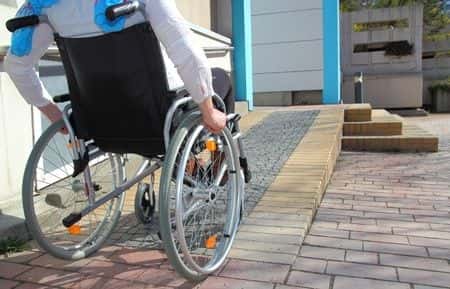Architecture Expert Comments on Fall Caused by Dangerous Entry Ramp
Updated on
This case involves an elderly male Plaintiff who slipped and then fell on a steep walkway that lead to the entrance of a pet supply store. The walkway in question had been designed and constructed at a very steep angle, which made it unusually difficult to walk on – a fact that had been noted by many of the store’s customers in the past. The man, who was in good health prior to this incident, fractured his hip, arm, and shoulder due to the fall. The ramp in question had a very unusual design and construction – its longitudinal slope varied significantly across the left, center, and right of its surface, and there was also noted to be a significant cross slope from the right to the left side of the ramp as well. In addition to the dangerous nature of the ramp’s design and construction, there was no guardrail or handrail for customers using the ramp to brace themselves on.
Question(s) For Expert Witness
1. Can you determine if the design of the slope fell below reasonable architectural standards?
Expert Witness Response E-006332
 After examining some dated aerial photos of the sight in question, it appears that the property in question has been constructed fairly recently, and that it has also been upgraded recently. It seems to have been built or renovated after 1991, which is when ADAAG accessibility guidelines (ANSI 117) governing these types of ramps began to be enforced. Paragraph 1003.4 and 1010.7 of ANSI 117 requires a slip resistant surface for ramps that is tested in both wet and dry conditions. Paragraph 1003.5 defines that a sloped surface can be used if the elevation is less than 12″, but if the slope is greater then 12″ then a ramp is required.
After examining some dated aerial photos of the sight in question, it appears that the property in question has been constructed fairly recently, and that it has also been upgraded recently. It seems to have been built or renovated after 1991, which is when ADAAG accessibility guidelines (ANSI 117) governing these types of ramps began to be enforced. Paragraph 1003.4 and 1010.7 of ANSI 117 requires a slip resistant surface for ramps that is tested in both wet and dry conditions. Paragraph 1003.5 defines that a sloped surface can be used if the elevation is less than 12″, but if the slope is greater then 12″ then a ramp is required.
 Considering the fact that this structure had a slope over 12″ it can therefore be considered a ramp. There is a provision for ramps to have hand rails and contrasting floor finish materials, as well as proper lighting. Additionally, if the width of this ramp is as wide as it appears to be, then both side rails and a center rail would be required (Section 1010 defines guidelines for ramps). As for the very step slope of this ramp, If it is along an accessible route or a means of egress, then this steep slope is a code violation. In addition, if the rise of the ramp is greater than 30″ then a landing is required at the bottom and at the top at the entry door, which this ramp appears to lack. This becomes a high risk situation for lots of folks, especially those who are elderly and those in wheel chairs or with eye sight difficulties. This appears to be a very dangerous structure that could easily cause an accident of this nature.
Considering the fact that this structure had a slope over 12″ it can therefore be considered a ramp. There is a provision for ramps to have hand rails and contrasting floor finish materials, as well as proper lighting. Additionally, if the width of this ramp is as wide as it appears to be, then both side rails and a center rail would be required (Section 1010 defines guidelines for ramps). As for the very step slope of this ramp, If it is along an accessible route or a means of egress, then this steep slope is a code violation. In addition, if the rise of the ramp is greater than 30″ then a landing is required at the bottom and at the top at the entry door, which this ramp appears to lack. This becomes a high risk situation for lots of folks, especially those who are elderly and those in wheel chairs or with eye sight difficulties. This appears to be a very dangerous structure that could easily cause an accident of this nature.
About the author
Joseph O'Neill
Joe has extensive experience in online journalism and technical writing across a range of legal topics, including personal injury, meidcal malpractice, mass torts, consumer litigation, commercial litigation, and more. Joe spent close to six years working at Expert Institute, finishing up his role here as Director of Marketing. He has considerable knowledge across an array of legal topics pertaining to expert witnesses. Currently, Joe servces as Owner and Demand Generation Consultant at LightSail Consulting.
Subscribe to our newsletter
Join our newsletter to stay up to date on legal news, insights and product updates from Expert Institute.
Sign up nowFind an expert witness near you
What State is your case in?
Subscribe to our newsletter
Join our newsletter to stay up to date on legal news, insights and product updates from Expert Institute.



